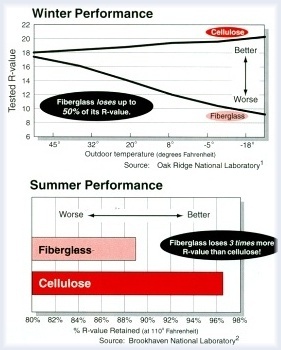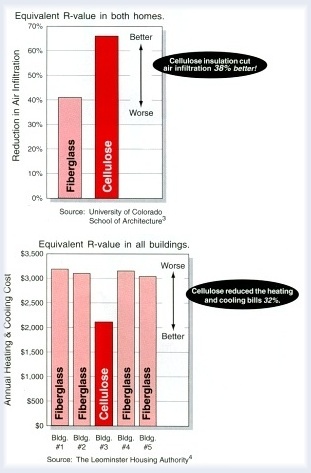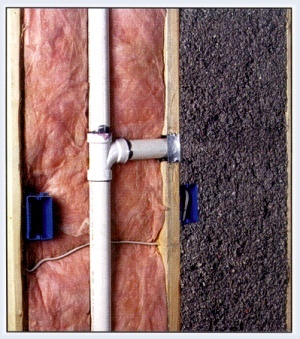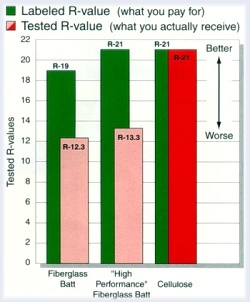 |
 |
 |
 |

|


|
|
|
|
|
|
#1
|
||||
|
||||
|
Blown in cellolose insulation
Anybody done this? One of my long time clients wants me to insulate the attic of his rental, it's an older Mediterranean style house, there's a shed roof on the front half of the house, a flat roof on the back half, well, almost flat, sloped slightly for drainage.
In the attic, the flat part of the roof has about 12 inches of 'crawl space,' not much of a crawl space. Home Depot will let me use their machine for free with a minimum purchase of the insulation, which I'll meet easily. I'm going to use fiberglass bats on the front part, as that's where the access panel is and I don't want the damn cellulose dribbling out through the opening. Should one use a vapor barrier with this stuff? Perhaps heavy plastic rolled out somehow over the joists? I get the impression that in our milder climate, people often dispense with it.
__________________
1986 300SDL, 362K 1984 300D, 138K |
|
#2
|
||||
|
||||
|
I would never use cellulose. I would use fiberglass blowing wool. and yes always use a vapor barrier on ceilings as well as walls.
Tom W
__________________
[SIGPIC] Diesel loving autocrossing grandpa Architect. 08 Dodge 3/4 ton with Cummins & six speed; I have had about 35 benzes. I have a 39 Studebaker Coupe Express pickup in which I have had installed a 617 turbo and a five speed manual.  [SIGPIC] [SIGPIC]..I also have a 427 Cobra replica with an aluminum chassis. |
|
#3
|
||||
|
||||
|
I haven't seen blown in fiberglass around here. Why don't you like the cellolose?
__________________
1986 300SDL, 362K 1984 300D, 138K |
|
#4
|
|||
|
|||
|
I blew in cellulose into the attic and a ceiling space in my house 18 yrs ago. No complaints about it, but I'm no expert on its R-value.
However, I do have important installation advice. Make sure the blower has a control switch at the nozzle end. When we did it, I was in the attic, my wife was out in the backyard running the machine and communication was very difficult. She was stuffing insulation into the hopper as I was slowly being buried once a section was complete.
__________________
1977 300d 70k--sold 08 1985 300TD 185k+ 1984 307d 126k--sold 8/03 1985 409d 65k--sold 06 1984 300SD 315k--daughter's car 1979 300SD 122k--sold 2/11 1999 Fuso FG Expedition Camper 1993 GMC Sierra 6.5 TD 4x4 1982 Bluebird Wanderlodge CAT 3208--Sold 2/13 |
|
#5
|
||||
|
||||
|
. . . . . and he was never heard from nor seen again . . . .
Good tip. The owner wants to help me with this, he's a good guy and fairly handy -- we're going to do it on a Saturday so I can afford to use my cell like a walkie talkie.
__________________
1986 300SDL, 362K 1984 300D, 138K |
|
#6
|
||||
|
||||
|
I blew in 15 inches of cellulose and it made a huge difference on how often the A/C and heater kicked on. It can get a but dusty installing it, but the cost made it worth while.
__________________
http://i284.photobucket.com/albums/l...aman/Fleet.jpg Peach Parts W124.128 User Group. 80 280SL 85 300SD 87 300TD 92 300D 2.5 Turbo 92 300TE 4Matic |
|
#7
|
|||
|
|||
|
Tom - Whats the logic of the vapor barrier in the clg? I'm in the same mild climate as the OP and have never seen that before. In fact, roofing codes here require numerous open vents at teh ridge line to allow heat (and vapor?) to escape.
I do have a vapor barrier covering teh soil in the foundation crawlspace becaue I live below a hill that can have some runoff in El Nino years. The visqueen slows/prevents vapor transmission to the underside of the wood floor joints and sheathing. Seems like at some point you would want to allow vapor to escape rather than be retained in the structure wouldn't you? Maybe its a cold/snow thing?
__________________
Terry Allison N. Calif. & Boca Chica, Panama 09' E320 Bluetec 77k (USA) 09' Hyundai Santa Fe Diesel 48k (S.A.) |
|
#8
|
||||
|
||||
|
Do not block the vents from the soffit or the bird-blocks. They make a rigid foam sheet with air channels to keep the air flowing. I have seen people blow that stuff all over the place and block up the ventilation the attic needs to breath. Mold and mildew can be a real health hazard and difficult to get rid of.
Make sure to take the proper precautions and not breath that junk. Do not roll plastic over the ceiling joists! As heat escapes up thru the sheetrock it would condense into moisture under the plastic. Your attic must breath!
__________________
79 240D (no name yet) 203K Miles Maple Yellow 98 2500 4x4 HD Dodge 24 Valve Cummins TD 83 Chevy Van (Dead-Trans. shot) |
|
#9
|
||||
|
||||
|
Cellulose has chemicals in it to make it fire resistant. They are toxic. It is hospitable to critters who will build nests in it. It will blow around and leave blank spots. If there is a roof leak it will compact and become a worthless rigid non insulating mass.
Fiberglass will do none of that. Cellulose's only virtue is that it is cheaper. YOu might have to look around a bit to find it but its available from the major fiberglass insulationmanufacturers. A vapor barrier is a completely different thing than an attic vent. Vapor barriers keep humidity in a home when its desireable. Around here it gets pretty cold. IN the winter the humidity inside is desired to be at least forty percent. The outside air which is much colder cannot hold much moisture and when it is let inside from cracks and opening the doors becomes very very devoid of moisture causing the home to dry out excessively. When a house is too dry you get static electricity everywhere and your sinuses will dry and crack and you are much more susceptible to catching viruses etc. A vapor barrier holds the moisture inside where its desired. Without one you can and do get moisture condensing on things like rafters and sheathing. It is a much misunderstood phenomina. It is required building codes but its so misunderstood that most building officials do not enforce the code provisions. I have been requiring vapor barriers in my buildings for over thirty years. People often tell me they will make my insulation wet but so far it has not. In the last fifteen years or so most folks have started using them on ceilings as a matter of course. If you are in a place where you don't need heat like san diego perhaps then perhaps you don't need a vapor barrier....I really don't know.....I could figure it out probably but it seems too complicated at the moment. Attic vents are needed too but they are for getting rid of excess heat in the attic to preserve the integrity of the shingles and keep the cooling load for the habitable space down. Tom W
__________________
[SIGPIC] Diesel loving autocrossing grandpa Architect. 08 Dodge 3/4 ton with Cummins & six speed; I have had about 35 benzes. I have a 39 Studebaker Coupe Express pickup in which I have had installed a 617 turbo and a five speed manual.  [SIGPIC] [SIGPIC]..I also have a 427 Cobra replica with an aluminum chassis. |
|
#10
|
||||
|
||||
|
Make sure the machine works before you leave the store. A few years back I had to send a few of the back to the vendor because they kept breaking, and they kept sending back broken machines
 ... ...
__________________
1999 Toyota Corolla VE (Mine) 2006 Honda Odyssey (Wife's) 1979 300CD (sold) |
|
#11
|
||||
|
||||
|
.
Vapor barriers are needed in some climates, and can cause harm in others. The easiest way to find recomedations for your area is to ask the guys at the pro desk where you get your insulation. And you can check with the local code inspector for a definitive answer. Your local court house should be able to get you in contact with them. Cellulose insulation is not toxic. It is basically ground up newspaper. The chemical most often used to treat the cellulose is boric acid. Boric acid is about as harmfull to humans as table salt. But it makes one heck of a good fire retardent and bug repellant, and controll the fision rate of uranium  http://en.wikipedia.org/wiki/Boric_acid Check the package of the insulation you buy to make sure of the chemicals used. No sense in breathing a bunch of nastiness if you dont have to. Home Depot and Lowes sell a very good, eco friendly, mostly recycled content, cellulose insulation. I forget the name right now. And it is usually the cheapest.  The machines that you get to rent for free almost never have an on/off switch located at the end of the hose. Just stick your hand over the end of the hose to stop the output of insulation, but dont do it for too long or the hose will clog. And make sure the guy feeding the hopper can hear you scream. Taping a long stick, like a broom handle, to the end of the hose makes the job a little easier. And you will probably want a face mask of some sort, and a powerfull flashlight. It gets dark in the attick with all that insulation floating around. Its almost impossible to load insulation into the hopper without making a mess. Setting the hopper on a tarp helps make cleanup easier. And if at all possible keep the hopper outside ! Or you will be dusting off everyting in the house. Dont ask me how I know that one  ... Fiberglass is dangerous.... In July of 1994, the federal government labeled fiberglass as a substance that quite possibly could be a carcinogen. However, the U. S. Department of Health and Human Services, in a letter to Congress, exclaimed that they felt that fiberglass does not pose a threat to persons in their daily lives. The risk appears to be centered around the fact that when installing either blown or batt type fiberglass, small glass fibers become airborne. .... Cellulose vs. Fiberglass The following is a summary of an extensive Natural Resources Defense Council (NRDC) report. The NRDC is a non-profit environmental membership organization with over 300,000 members and contributors nationwide: The NRDC has concluded the following: http://www.houleinsulation.com/cellulose_vs_fiberglass.html
~ Dr. Arthur Furst, Toxicologist Why Cellulose?
Will My Choice of Insulation Really Effect My Monthly Heating & Cooling Bills?YES!  Different insulations are made from fundamentally different materials. Tests at Oak Ridge and Brookhaven National Laboratories and the University of Illinois reveal that insulations with the same laboratory R-values do not perform equally in real homes. Researchers found that the effective R-value of blown fiberglass plunges during cold weather, while the effective R-value of cellulose actually increases. The researchers also discovered that summer temperatures offer no relief for fiberglass, since its effective R-value withers then, too. Different insulations are made from fundamentally different materials. Tests at Oak Ridge and Brookhaven National Laboratories and the University of Illinois reveal that insulations with the same laboratory R-values do not perform equally in real homes. Researchers found that the effective R-value of blown fiberglass plunges during cold weather, while the effective R-value of cellulose actually increases. The researchers also discovered that summer temperatures offer no relief for fiberglass, since its effective R-value withers then, too. Utility bills were 32% lower in the cellulose insulated building. ~ Leominster Housing Authority  Cellulose helps keep your home warmer in the winter, cooler in the summer, blocks air infiltration, and saves you money! Do Different Installation Methods Make a Difference?The walls, ceilings, and floors of your home are full of odd shaped cavities and obstacles like plumbing, air ducts, and wiring. For your insulation to work effectively, it must completely fill around these obstructions without gaps or voids. Installation is critical in determining how insulation performs in your home. How well does it fit in different size wall cavities and around countless obstacles? Is it cut and patched in? Or is it custom fit? Cellulose insulation is sprayed or blown into walls, conforming to your home and surrounding you and your family with a seamless insulation system. Fiberglass batts, on the other hand, are cut and pieced together, leaving gaps, voids & areas of compression. A Difference You Will See, Feel, and Enjoy  Installing cellulose insulation in your existing home is one of the best decisions you can make for yourself and your family. Walls are fully and tightly insulated, forming a monolithic thermal barrier. No more gaps. No more voids. No more drafts. Just years of comfort. Getting What You Paid For  Tests conducted by a fiberglass manufacturer reveal that the actual performance of batts can be 14% to 45% less than their labeled R-value when gaps and voids associated with normal batt installation are considered. With cellulose insulation, you receive the insulation performance you paid for. Tests conducted by a fiberglass manufacturer reveal that the actual performance of batts can be 14% to 45% less than their labeled R-value when gaps and voids associated with normal batt installation are considered. With cellulose insulation, you receive the insulation performance you paid for. .... The Colorado StudyEnergy Conservation vs. Fiberglass In December 1989 and January 1990 the University of Colorado at Denver School of Architecture and Planning studied the energy conservation efficiency of two test buildings that differed only in the insulation systems that had been installed. Building "A" was insulated with 5.5 inches of sprayed-in cellulose in the walls and R-30 of loose-fill cellulose in the ceiling. Building "B" received R-19 unfaced fiberglass batts in the walls and R-30 kraft-faced batts in the ceiling. Over the two-month period a number of different tests and measurements were performed. Here's what the University researchers learned.
Cellulose insulation benefits not covered by the University of Colorado study include:
RichC  .
__________________
When the power of love overcomes the love of power the world will know peace. Jimi Hendrix |
|
#12
|
||||
|
||||
|
That all looks a lot like advertising material.
I was told of the toxic nature of it by a chemical engineer who was a client. Perhaps since that was thirty years ago, it is made with different chemicals now. I do not believe the part about it not settling. Tom W
__________________
[SIGPIC] Diesel loving autocrossing grandpa Architect. 08 Dodge 3/4 ton with Cummins & six speed; I have had about 35 benzes. I have a 39 Studebaker Coupe Express pickup in which I have had installed a 617 turbo and a five speed manual.  [SIGPIC] [SIGPIC]..I also have a 427 Cobra replica with an aluminum chassis. |
|
#13
|
|||
|
|||
|
My home was built in 1977 and originally insulated with cellulose. I can tell you without a doubt cellulose settles or compacts. I have to assume when this happens that it has some effect on R value. If I have the extra $$$ this fall I'm going to add at least 6-8 inches of cellulose to my attic. It's a nasty job but you save a lot of money doing it yourself. As others have said, make sure you don't block any vents, have good lighting and wear a good quality mask.
__________________
1995 Toyota Pickup 2003 Suzuki Burgmann 400 2002 VW Passat 4Motion V6 1957 Aristocraft Torpedo Boat |
|
#14
|
||||
|
||||
|
The way that insulation works is by trapping air in small enough pockets that it cannot convect. Settling most definately degrades its performance.
Tom W
__________________
[SIGPIC] Diesel loving autocrossing grandpa Architect. 08 Dodge 3/4 ton with Cummins & six speed; I have had about 35 benzes. I have a 39 Studebaker Coupe Express pickup in which I have had installed a 617 turbo and a five speed manual.  [SIGPIC] [SIGPIC]..I also have a 427 Cobra replica with an aluminum chassis. |
|
#15
|
||||
|
||||
|
We blow fiberglass into the roofs of all the new houses we do. Its pretty cheap, and works well.
The guys come out with a truck, and throw bags of it into the pump, doesn't take long to do either. But it makes a mess!
__________________
1999 SL500 1969 280SE 2023 Ram 1500 2007 Tiara 3200 |
 |
| Bookmarks |
|
|